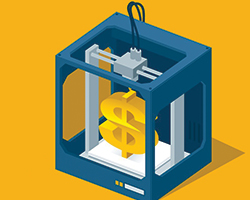 Most products are made of many parts. They result from many manufacturing steps performed by different machines, each with its own operator. 3-D printing replaces these steps with fundamentally different machines that make finished products, with all their parts, fully assembled.
Most products are made of many parts. They result from many manufacturing steps performed by different machines, each with its own operator. 3-D printing replaces these steps with fundamentally different machines that make finished products, with all their parts, fully assembled.
Revolutionizing Product Design
Products have always been slaves to how they can be made. If a design cannot be made with traditional machines, it remains trapped on paper or in a computer. Thus, product designers have been forced to design for manufacture. 3-D printing changes that. In a 3-D-printed world, designers no longer need to design for the limitations of existing machines because 3-D printers can build almost any design, regardless of complexity. With virtually no limitations on manufacturing, 3-D printers turn the creative process on its head. Product designs no longer need to be broken into multiple parts, according to manufacturing constraints. Designers can immerse themselves in the creative process because they can 3-D print prototypes immediately. The mediocrity and monotony of mass-produced designs can be replaced with mass-customized designs. Because almost any product can be 3-D printed, the design can follow the designer’s vision and is limited only by the imagination.
Customers Become Manufacturers
3-D printers can be used by not just traditional manufacturers but also by their customers. This is happening today. RMIT University in Australia used 3-D printing to repair hundreds of turbine blades used by a power generation company. Without this process, the blade manufacturer would have sold hundreds of new replacement blades, but it looks like it will be selling far fewer new blades as time, and blades, wear on.
The refurbished parts are as good as or better than the originals, and the process costs far less than buying a new part. This is great news for the part owner and terrifying for the blade manufacturer. By using 3-D printing to repair the blades, the customer no longer needs to buy new ones and has blurred the line between customer and manufacturer.
Companies Must Adapt or Die
IBM wrote in a 2013 3-D printing study that “for leading global companies to prosper in this new environment, radical change is essential.” Some companies will take full advantage of the implications of 3-D printing. Other companies will not be so lucky, and many are sleeping at the wheel. In the manufacturing climate of 3-D printing, they must adapt or die. For example, the turbine blade manufacturer will be forced to adapt if most of its customers use 3-D printing to repair their blades rather than buy new ones. It may find that licensing the digital blueprints for the blades beats making and selling them.
What Does ‘Genuine’ Mean?
In a 3-D-printed world, companies may find their products competing not only with their traditional competitors’ products but also with 3-D-printed copies of their own products, with customized versions of their own products, and with generic substitutes for their products. Such products may be made by professional counterfeiters, 3-D print shops, industrial customers or consumers. Manufacturers will be forced to police the marketplace for copies of their products, to find ways to identify genuine products, and to try to stop poor-quality and dangerous copies. Determining what products are genuine will be much more complicated in a 3-D-printed world, and the word “genuine” could eventually become meaningless.
John Hornick is a partner with Washington, D.C.-based Finnegan IP law firm and founder of its 3D Printing Working Group.














Speak Your Mind
You must be logged in to post a comment.